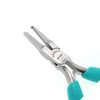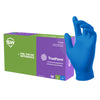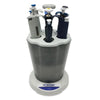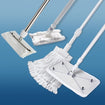- No products in the cart.
The Importance of Cleanroom Equipment when Producing Nanomaterials for Glucose Sensors
Jun
13
2020
Diabetes affects around 200 million people in the world. By 2030, that number is expected to grow to 300 million. Diabetes is characterized by the body’s inability to either produce or respond to insulin to regulate blood sugar. When left untreated, uncontrolled blood sugar levels can cause impair heart health, kidney function, vision, and more.
Glucose sensors have allowed many of those suffering from this disease to quickly, safely, and efficiently monitor their disease on a day-to-day basis. However, traditional fabrication of these enzymatic glucose-sensing devices can be expensive.
Recently, non-enzymatic glucose sensing devices have come to the forefront of glucose sensing technologies. These non-enzymatic devices typically use a metal or metal oxide, which can directly oxidize glucose in the blood without the use of enzymes. This reaction is then used as a readout to measure levels of glucose in the sample. Many of these non-enzymatic glucose-sensing devices also apply the use of nanomaterials to increase their efficiency.
When fabricating these nanomaterials for glucose sensors, special precautions need to be taken to ensure that the device is not compromised by contaminants. Studies have found that up to 80% of potential contaminants in a cleanroom come from personnel. Therefore, it is important to consider the types of contaminants that may be present in your lab and how to avoid them.
Nanomaterials for Glucose Sensors and Your Cleanroom
Nanostructures such as nano-rods, nano-sheets, and nano-particles increase the surface-to-volume ratio of glucose sensing devices. Ultimately, this helps increase the sensitivity and efficiency, requiring less material for an accurate test. However, it is also important that these nanomaterials for glucose sensors are kept free of contaminants in order for the final device to work the way it’s been designed to. That’s where the correct use of a cleanroom can save you time and money.
Some potential threats of contamination include:
- Dust/particulate debris
- Smoke
- Microbes
- Personnel movement
- Human error
- Improper airflow
- Incorrect equipment or equipment use
Particulate contamination of your nanomaterials during fabrication can cause them to not work properly. Even worse, microbial contamination could lead to toxicity to the patient. Since glucose-sensing devices are used by the patient directly to monitor their disease, either of these contaminations could have devastating effects.

Keeping Your Cleanroom Clean
The best cleanrooms start with good design and end with standardized, continuous good practices. Ensure your cleanrooms follows appropriate guidelines and establish clear standard operating procedures to keep personnel informed. Only approved cleanroom apparel should always be worn in the cleanroom and it should always be donned appropriately. Moreover, tools should be carefully decontaminated with the appropriate sanitizer before entering the cleanroom. Finally, personnel should minimize movements to only what is required to accomplish their duty and always move with precision.
Working with Nanomaterials in the Cleanroom
When working with nanomaterials for glucose sensors, it is particularly important that they are handled appropriately. Improper handling of these materials can result in damage and, therefore, reduced efficiency and costly re-work. Carefully identify the material and shape of the tools you use to move your materials to avoid damage and allow precise movement. Often, tweezers are most appropriate for moving small items around your cleanroom. Always be sure that any tools that touch your nanomaterial units directly are decontaminated appropriately before use.
It is good practice (and often a requirement) that you visually monitor your units as they are produced. Since nanomaterials can’t be evaluated by eye, it’s best to use a microscope to regularly check for imperfections, damage, or contamination. It’s also equally important that your microscope, along with any other equipment that comes into contact with these nanomaterials, is free of contaminants. Sanitize and wipe your equipment regularly to reduce the risk of contamination of these delicate nanosurfaces.
A Well-Managed Cleanroom Saves Money and Time
Nanomaterials for glucose sensors are quickly advancing the future of glucose-sensing devices. The application of both nanostructures and non-enzymatic reactions is driving a new generation of glucose sensors that are more affordable, stable, sensitive, quick, and biocompatible than their predecessors. This will translate to easier access and better testing options for patients in the future.
However, when working with nanomaterials, it’s important to understand the factors that can decrease their effectiveness. When your cleanroom has standardized procedures, knowledgeable personnel, and the right equipment, you help avoid these problems. An appropriately used cleanroom and related tools can be your best defense from expensive defects and delays.
__
For over 40 years, Lab Pro has been committed to delivering the highest quality cutters, tweezers, microscopes, chemicals, and cleaning solutions to medical device and biotechnical laboratories worldwide. Come visit the biggest Lab Supply showroom in the Bay Area, or contact us online or at 888-452-2776.














































